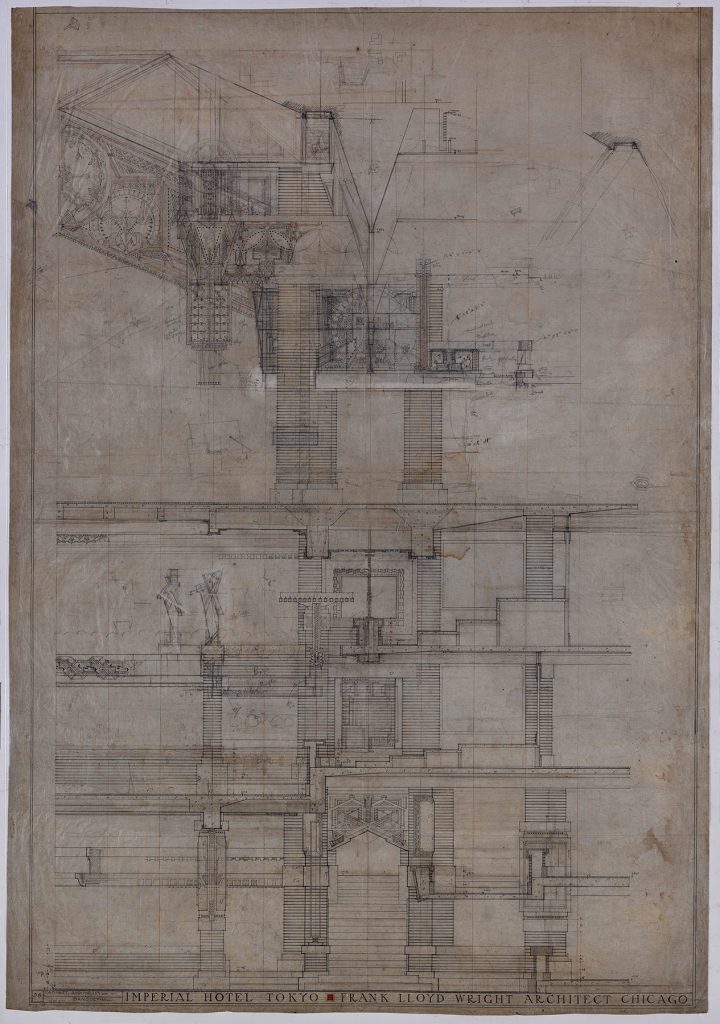Avery Library’s Drawings & Archives department is pleased to participate in a landmark touring exhibition about the international influence of Frank Lloyd Wright, Frank Lloyd Wright and the World: The Imperial Hotel at 100. Opening to the public on October 21, 2023 at Japan’s Toyota Municipal Art Museum, the exhibition is organized by the Tokyo Shimbun and the Frank Lloyd Wright Foundation with the special cooperation of Avery Library. The exhibition takes an expansive look at the work of Wright around the world and includes a celebration of the 100th anniversary of the completion of Wright’s famed Imperial Hotel commission in Tokyo. Over the next six months, the exhibition will travel to three venues: the Toyota Municipal Art Museum, the Panasonic Shiodome Museum of Art, Tokyo, and the Aomori Museum of Art.

“The Imperial Hotel was an incredible chapter in Wright’s career as his first international commission, and it brought to fruition his long standing dedication to and passion for Japanese culture. This exhibition is an exceptional platform to share Wright’s legacy with a Japanese audience, and we are pleased to loan 20 drawings from the collection,” said Dr. Michelle Jackson-Beckett, architectural historian and the curator of Avery Drawings & Archives.

Upon the hotel’s completion in 1923, the famed modern architect and former employer of Wright, Louis H. Sullivan penned an ecstatic essay on the design of the building in The Architectural Record: “Thus the architect who combines in his being the powers of vision, of imagination, of intellect, of sympathy with human need and the power to interpret them in a language vernacular and true—is he who shall create poems in stone[…] In this regard the Imperial Hotel stands unique as the high water mark thus far attained by any modern architect. Superbly beautiful it stands—a noble prophecy.”[1]
The Imperial Hotel survived several harrowing events, including the devastation of the Great Kantō earthquake in 1923 (Wright’s design was lauded as “quakeproof” in a headline by the North China Gazette in 1923), and World War II bombings that destroyed several important sections of the hotel. By the 1960s, the hotel had fallen into disrepair and was demolished in 1967 in favor of a new highrise building, to great controversy. The hotel’s extraordinary central lobby wing and the reflecting pool were disassembled and rebuilt at the open-air museum Meiji-mura in Nagoya. Today, the Imperial Hotel and surrounding site are undergoing yet another chapter of rebuilding and expansion expected to be completed in 2036.
About Wright at Avery
The Wright holdings in Avery Library, predominantly consisting of the Frank Lloyd Wright Foundation Archives held in the Drawings & Archives department, represent the most significant holdings of the architect’s material in the world. These collections are an essential resource for scholars, homeowners, and students. The archives include materials documenting nearly 1,100 architectural projects, with over 24,000 drawings, 32,500 photographs, and other materials such as Wright’s correspondence, manuscripts, and talk transcripts, as well as project specifications, oral histories, and films.
Questions? Please contact Avery Drawings & Archives: avery-drawings@columbia.edu
[1] [Louis H. Sullivan, “Concerning the Imperial Hotel, Tokyo, Japan,” The Architectural Record, Vol. 53 (1923): 332-352].